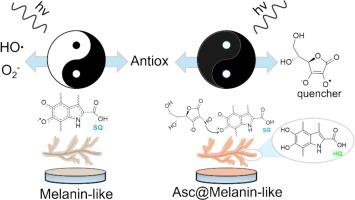Modulating the radical scavenging/generation ability of light-responsive melanin-like nanoplatforms by ascorbic acid treatment
IF 6.9
2区 材料科学
Q2 CHEMISTRY, PHYSICAL
引用次数: 0
Abstract
Redox-active nanomaterials represent powerful tools for therapeutics due to either antioxidant or pro-oxidant behavior that is essential in regulating the reactive oxygen species (ROS) levels in the biological systems. A promising way to design and realize bioinspired versatile redox-active nanoplatforms is offered by melanin polymers, which are widely available hydrophobic pigments made of poly(hydroxy indole) planar structures produced by oxidative polymerization of the monomeric precursors. Melanins can radically change the redox activity as a response to external stimuli such as acidification or light irradiation, thus exhibiting ROS-generating ability. Herein, the design of versatile light-triggered redox-active melanin-based nanoplatforms is proposed through a green photocatalytic/solvothermal approach. Extensive physicochemical characterization and radical scavenging assays are conducted to define the main properties of such nanomaterials. They exert a significant paramagnetic behavior together with a strong radical scavenging activity benefitting from post-reduction with ascorbic acid, due to increase in the colloidal stability at high concentrations. ROS generation by 2D melanin-based biointerfaces obtained by depositing thin layers on glass slides is activated by IR and UV light irradiation but quenched after redox exchange with ascorbic acid. This study contributes to the future development of sustainable light-responsive bioelectronic devices.


通过抗坏血酸处理调节光反应性黑色素样纳米平台的自由基清除/生成能力
氧化还原活性纳米材料由于其抗氧化或促氧化行为,在调节生物系统中的活性氧(ROS)水平方面是必不可少的,因此是治疗的有力工具。黑色素聚合物为设计和实现生物启发的多功能氧化还原活性纳米平台提供了一种很有前途的方法,黑色素聚合物是由单体前体氧化聚合产生的聚羟基吲哚平面结构制成的广泛使用的疏水色素。黑色素可以从根本上改变氧化还原活性,作为外部刺激的反应,如酸化或光照射,从而表现出ros生成能力。本文提出了一种基于绿色光催化/溶剂热方法的多功能光触发氧化还原活性黑色素纳米平台的设计。广泛的物理化学表征和自由基清除试验进行,以确定这类纳米材料的主要性质。由于在高浓度下胶体稳定性的增加,它们具有显著的顺磁性和强自由基清除活性,这得益于抗坏血酸的后还原。通过在玻片上沉积薄层获得的二维黑色素生物界面生成ROS,可通过红外和紫外线照射激活,但与抗坏血酸氧化还原交换后被猝灭。本研究为未来可持续光响应生物电子器件的发展做出了贡献。
本文章由计算机程序翻译,如有差异,请以英文原文为准。
求助全文
约1分钟内获得全文
求助全文
来源期刊

Applied Surface Science
工程技术-材料科学:膜
CiteScore
12.50
自引率
7.50%
发文量
3393
审稿时长
67 days
期刊介绍:
Applied Surface Science covers topics contributing to a better understanding of surfaces, interfaces, nanostructures and their applications. The journal is concerned with scientific research on the atomic and molecular level of material properties determined with specific surface analytical techniques and/or computational methods, as well as the processing of such structures.
 求助内容:
求助内容: 应助结果提醒方式:
应助结果提醒方式:


